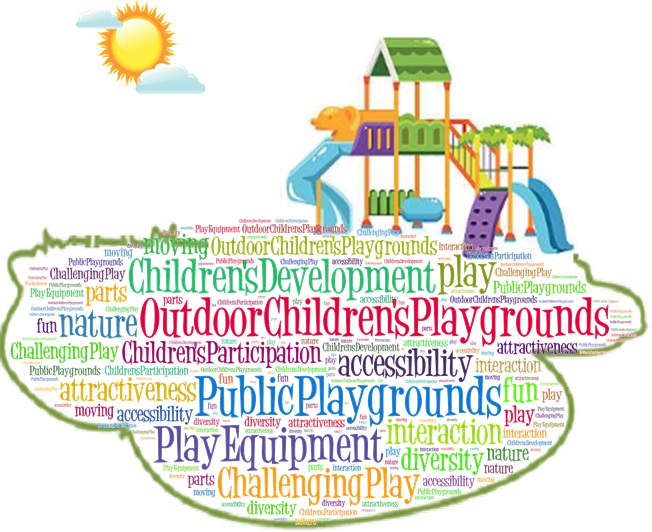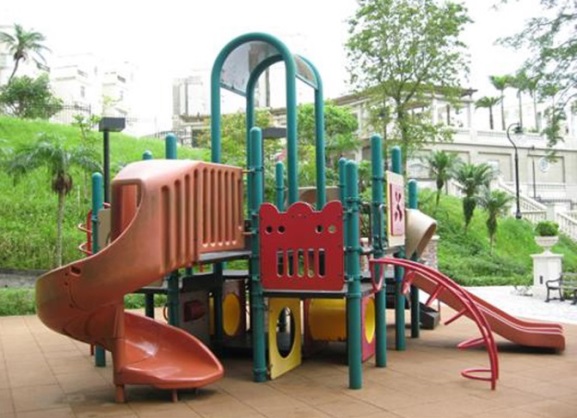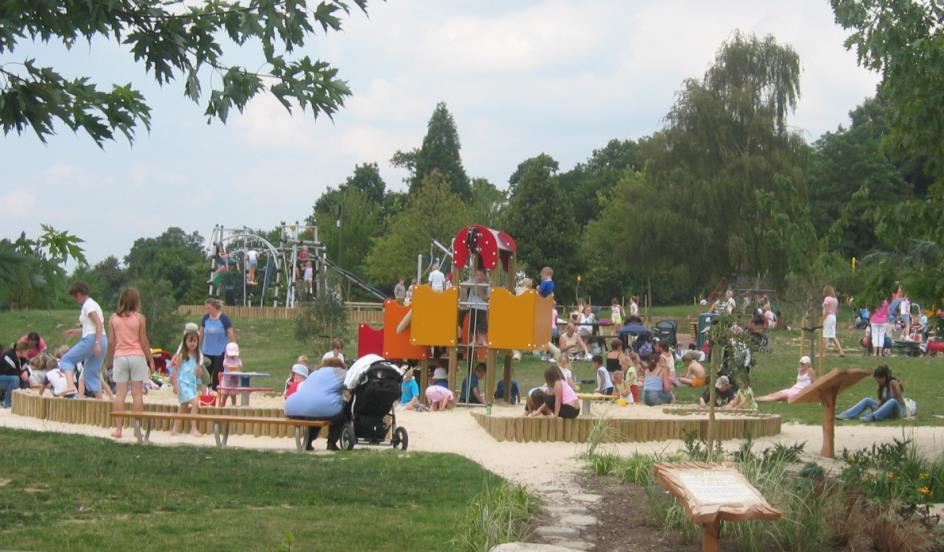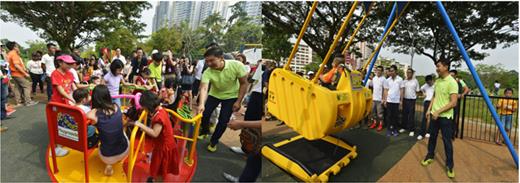ISE04/17-18
| Subject: | home affairs, outdoor children's playgrounds, public playgrounds |

- Play is recognized as a fundamental right for every child under Article 31 of the United Nations Convention on the Rights of the Child.1Legend symbol denoting Play is essential to the development of children's physical, cognitive and social skills. Through play, children can practise motor control and coordination of body movements, learn the physical world, and interact with others. Playgrounds have been the designed environment for children to enjoy their right to play, providing facilities for outdoor play and engaging children in play. They are of particular value to children in Hong Kong where the densely populated living environment has limited the availability of outdoor space in which they can play.
- Playgrounds in Hong Kong can be found in (a) public open space managed by the Leisure and Cultural Services Department ("LCSD"); and (b) non-LCSD venues which are mainly outdoor play facilities in private residential developments and in public housing estates provided by the Hong Kong Housing Authority2Legend symbol denoting As at end-April 2017, the Housing Authority ("HA") managed 179 housing estates, of which 158 (88%) were provided with slides, 30 (17%) with swings and 160 (89%) with climbing frames. The Research Office had written to HA for providing figures for the total number of HA-managed outdoor children's playgrounds and the total area occupied by these playgrounds. HA responded that it did not have readily available information on these two areas. and the Hong Kong Housing Society.3Legend symbol denoting As at end-April 2017, the Housing Society provided 22 outdoor children's playgrounds with a total area of 2 479 sq m. These playgrounds had a total of 26 slides, four swings and 13 climbing frames. In comparison, the playgrounds managed by LCSD are in general larger in size and have more diverse play facilities.
- In recent years, the playgrounds managed by LCSD have been criticized for not meeting children's needs for outdoor play activities.4Legend symbol denoting For example, see 香港遊樂場協會(2014), 香港保護兒童會(2017), Playright Children's Play Association (2015), 香港小童群益會(2016), 《最緊要好玩》,《遊樂場設施》and《遊樂場 不快樂》. In particular, they are too monotonous in design and the play equipment thereon is not exciting and fun enough to attract children. This issue of Essentials gives an overview of the LCSD-managed playgrounds, followed by a discussion of the key elements required for a successful playground as identified in the studies conducted by overseas government authorities, landscape architects and children's rights groups.5Legend symbol denoting For example, in 2008, the United Kingdom government published the first national play strategy and commissioned Play England, a registered charity, to set out the principle for creating successful play spaces. In the United Kingdom, Play England campaigns for all children to have freedom and space to play throughout childhood. Meanwhile, the Singapore government has conducted studies to identify how the different spaces in the playground can be designed and used optimally. In addition to the above, the Australian Institute of Landscape Architects released a policy statement in 2011 about the provision of play opportunities in Australia, and Canada's City of Toronto issued the guidelines regarding children's playgrounds in 2014.
LCSD-managed outdoor children's playgrounds
- LCSD currently manages more than 600 leisure venues provided with outdoor children's playgrounds6Legend symbol denoting In 2016-2017, LCSD changed the definition of children's playground from "the number of children's play area" to "the number of venues provided with children's playground". A venue with more than one children's play area is only counted once. ("public playgrounds"). According to LCSD, it has been committed to providing diversified play equipment for children in their public playgrounds, thus giving them opportunities to play together and acquire different skills. In recent years, the LCSD-managed playgrounds have attracted criticisms from the general public, especially the children's rights groups, with respect to the following areas:7Legend symbol denoting For example, see 香港遊樂場協會(2014), 香港保護兒童會(2017), Playright Children's Play Association (2015), 香港小童群益會(2016), 《最緊要好玩》,《遊樂場設施》and《遊樂場 不快樂》.
(a) uneven distribution of public playgrounds — As shown in Figure 1 below, the distribution of LCSD-managed playgrounds varied markedly among the 18 districts in Hong Kong at end-April 2017. Indicative of this, the average area of public playgrounds per child ranged from a low of 0.16 sq m in Kwai Tsing to a high of 0.55 sq m in the Central and Western district;
Figure 1 — Area of LSCD-managed public playgrounds at end-April 2017
District Area of public playgrounds*
(sq m)
(a)No. of children aged 2-12^
(b)Average area of public playgrounds per child
(sq m)
=(a)/(b)Central and Western 10 074 18 200 0.55 Wan Chai 5 487 13 200 0.42 Yau Tsim Mong 11 328 27 800 0.41 Wong Tai Sin 12 542 33 800 0.37 Islands 4 714 13 800 0.34 Kwun Tong 19 744 58 300 0.34 North 9 842 31 700 0.31 Tsuen Wan 7 818 25 800 0.30 Sham Shui Po 10 461 35 600 0.29 Tai Po 7 532 26 300 0.29 Tuen Mun 10 590 41 400 0.26 Southern 5 639 23 000 0.25 Sha Tin 11 963 55 400 0.22 Eastern 9 892 46 300 0.21 Sai Kung 8 130 38 900 0.21 Yuen Long 11 171 53 900 0.21 Kowloon City 6 609 38 600 0.17 Kwai Tsing 7 003 44 700 0.16 Total 170 539 626 900 0.27
Notes: (*) Area of public playground refers to the total size of children's play area(s) within a public playground. A public playground may include more than one children's play area.
(^) Figures may not add up to total due to rounding.
Data sources: LCSD (2017) and Census and Statistics Department (2016).(b) insufficient provision of play equipment — most of LCSD-managed public playgrounds provide multi-play equipment comprising slides, climbing frames and other facilities. Yet the number of multi-play equipment provided varied visibly among the 18 districts at end-April 2017 (Figure 2). As to free-standing play equipment, LCSD provided free-standing slides and free-standing climbing frames only in 9% and 11% of its managed public playgrounds respectively. Added to this, the provision of free-standing play equipment varied widely among the 18 districts;
Figure 2 — Number of play equipment in LCSD-managed public playgrounds at end-April 2017@
District No. of public playgrounds Slide Climbing frame Swing# free-standing multi-play free-standing multi-play free-standing Wong Tai Sin 15 1 15 4 7 13 Southern 19 2 18 0 7 2 Sham Shui Po 22 6 20 4 8 29 Wan Chai 25 1 18 2 3 13 Kowloon City 27 8 21 1 13 25 Islands 28 0 25 4 22 10 Sai Kung 30 3 25 6 11 14 Yau Tsim Mong 31 2 26 2 12 11 Sha Tin 33 7 28 19 21 13 Eastern 35 7 28 2 24 22 Tsuen Wan 35 2 29 2 25 5 Tuen Mun 36 0 32 1 16 4 Kwun Tong 37 0 33 9 24 18 Kwai Tsing 38 0 35 0 7 14 Central & Western 45 13 25 1 18 18 Tai Po 49 1 43 1 7 2 Yuen Long 50 1 44 9 33 13 North 80 3 63 1 54 5 Total 635 57
(9.0%*)528
(83.1%*)68
(10.7%*)312
(49.1%*)231
(36.4%*)
Notes: (@) Highlighted figures show the lowest and highest numbers of slides, climbing frames and swings provided among the 18 districts.
(#) There is no multi-play children play equipment provided with swing.
(*) Percentage share of the public playgrounds with the free-standing or multi-play play equipment in question provided.
Data source: LCSD (2017).(c) monotonous design of playground — LCSD-managed public playgrounds feature a widespread use of proprietary modular multi-play equipment that meets the internationally recognized safety standards (Figure 3). The identical playground design, though safe and easier in maintenance, has been criticized for being boring and failing to satisfy the playing needs of children.8Legend symbol denoting Ibid. For instance, 99.2% of the slides in LCSD-managed public playgrounds have a height of two meters or less.9Legend symbol denoting At end-April 2017, there were a total of 57 free-standing slides in LCSD-managed public playgrounds and 55 or 96.5% of them were slides of two metres or less in height. As to the multi-play play equipment, 1 233 or 99.4% of its 1 241 composite slides had a height of two meters or less. While such low structures allow a level of interaction between younger children and their parents, older children who could play without adult assistance might find the slides unchallenging for being too short to go down.
Besides, many LCSD-managed public playgrounds lack elements of nature in their set-up. For example, Hong Kong Park is the only LCSD public playground with a sandpit for children to play. According to some studies,10Legend symbol denoting See City of Toronto (2014), Play England (2008) and Woolley and Lowe (2013). children value the chance to interact with natural materials such as water, plants, rock and sand;
Figure 3 — Mount Austin Playground, Hong Kong

Source: LCSD (2017).(d) insufficient channels for community to participate in the design process — LCSD has been mainly liaising with the District Council and the relevant concern groups on the design of public playgrounds and the play equipment thereon. It was not until 2016 that LCSD conducted a pilot scheme to collect ideas from children aged 8-15,11Legend symbol denoting During 2016-2017, LCSD and the Architectural Services Department supported Playright Children's Play Association to implement the Junior Playground Commissioner Incubation Programme @Tuen Mun. The programme is to collect ideas from Primary 3-6 students aged 8-11 and Secondary 1-3 students aged 12-15 on the design of the children's playground of Tuen Mun Park through workshops and dialogue. as well as adopting the winning designs from a competition,12Legend symbol denoting UNICEF HK, Playright Children's Play Association and the Hong Kong Institute of Landscape Architect jointly organized a competition in 2015 to gain creative ideas from students and professionals on the design of the children's playground of Tuen Mun Park. in the design of an inclusive playground in Tuen Mun Park. The former arrangement should help ensure children's needs are fully reflect in the design and construction of play spaces;13Legend symbol denoting Article 12 of the United Nations Convention on the Rights of the Child guarantees the opportunities for children to be heard on all matters of concern to them. This implies, among other things, the involvement of children in the planning and designing for their own play space. and (e) insufficient inclusive facilities — according to LCSD, about 70% of its public playgrounds currently offer diversified inclusive play equipment. Yet, there have been concerns that the current design of LCSD-managed public playgrounds might not facilitate a true inclusive play space to cater the needs of the disabled children. For example, the stairs of the composite play structure do not facilitate children with physical and visual disabilities using the slides.14Legend symbol denoting See Siu, K.W. et al. (2016). There is also a lack of suitable facilities encouraging children of different ages and abilities to play together.
Nevertheless, Hong Kong will see the opening of the first public playground with a brand new concept of inclusive play and barrier-free facilities in Tuen Mun Park in late 2017. Unlike other LCSD-managed public playgrounds, the design and construction of the playground in Tuen Mun Park have incorporated fun components and themed facilities that encourage children of different abilities and ages to share the play space and interact with each other.
Elements of a successful children playground
- Playground is not simply a collection of play equipment, and the discussion of a successful children playground should cover the overall design of the playground as well. In recent years, there have been studies conducted to identify the key elements required for a successful playground that allow children the fullest play experiences.15Legend symbol denoting See endnote 5. The common key elements identified include:
(a) variety — good play spaces should offer a wide range of play experience for children of different ages, such as sandpits for younger children, climbing facilities for older children, and seesaws and merry-go-round for children of different ages playing together (Figure 4);
Figure 4 — Horsham Park, England*

Note: (*) The playground features a mix of play equipment, interactive spaces and sandpit.
Source: Horsham District Council (undated).(b) access to the natural environment — experts have noted the importance of including natural elements such as sand, water and trees in the playgrounds, as access to the natural environment encourages children's imagination and improves children's cognitive and sensory development; (c) flexibility — successful play spaces can be used in different ways by children of different ages. Fundamental to this concept is the idea of non-prescriptive play equipment and features, which put play in the control of children and encourage imagination and creativity. Constructive play with loose parts is, thus, highly valued; (d) engaging with communities — the process of creating successful play spaces will always need prospective users (including children if possible) to articulate their concerns as well as their needs and aspirations. A successful community engagement process will help create a playground that the community likes and which meets its needs; and (e) inclusiveness — successful play spaces should be as inclusive as possible to support equality of access and provision of play opportunities for children of different ages and abilities, as well as to support the needs of accompanying caretakers. In addition to the provision of inclusive play equipment, considerations of designing an inclusive playground might include one or more of the following: (i) accessible entrances to and walkways within the playground for children with mobility issues; (ii) different degrees of challenge and scale within the play activities; and (iii) suitable facilities to address the needs of children's caretakers (Figure 5).
Figure 5 — Bishan-Ang Mo Kio Park, Singapore*

Note: (*) Bishan-Ang Mo Kio Park is the second inclusive playground in Singapore with a range of special needs friendly equipment (e.g. wheelchair swing).
Source: Singapore National Council of Social Service (2015).
Concluding remarks
- In recent years, there have been growing concerns about how safety is being addressed in children's play provision. Contemporary playgrounds, though safe for children, might lack diversity and discourage children to take on challenges and interact. In some developed economies, there are discussions abound of the need for the shift from conventional risk assessment to risk-benefit assessment.16Legend symbol denoting For example, see Play England (2012) and City of Toronto (2014). Risk-benefit assessment improves on the conventional risk assessment in terms of explicitly incorporating benefits of play into the design process, instead of focusing primarily on risk elimination.
- While variety, access to the natural environment, flexibility, engaging with communities, and inclusiveness are key elements for a successful children playground, play activities with manageable level of challenge should help boost the appeal of play environment to children and the concomitant benefits of play to them.
Prepared by Samantha LAU
Research Office
Information Services Division
Legislative Council Secretariat
12 December 2017
Endnotes:
References:
| 1. | Architectural Services Department. (2007) Universal Accessibility for External Areas, Open Spaces and Green Spaces.
|
| 2. | Atmakur, S. (2013) Focus: Playgrounds of inclusion.
|
| 3. | Australian Institute of Landscape Architects. (2011) Play in the Urban Landscape.
|
| 4. | City of Burnside. (2014) Playground Strategy 2014-2024.
|
| 5. | City of Toronto. (2014) Playground: Early Learning and Care Assessment for Quality Improvement.
|
| 6. | City of Wollongong. (2014) Play Wollongong Strategy.
|
| 7. | Greater London Authority. (2016) The London Plan 2016.
|
| 8. | Kelly, M. (2016) Building dynamic playgrounds.
|
| 9. | Leisure and Cultural Services Department. (2017) Play equipment for all children.
|
| 10. | Ontario Ministry of Education. (2014) How Does Learning Happened.
|
| 11. | Play England. (2008) Design for Play: A guide to creating successful play spaces.
|
| 12. | Play England. (2012) Managing Risk in Play Provision: Implementation Guide.
|
| 13. | Playright Children's Play Association. (2015) Press Release: Local Playgrounds unvisited for ¼ of the time during peak hours reflects the lack of fun and challenge of the facilities. Experts announce observation report on Hong Kong playgrounds and call for "better playgrounds".
|
| 14. | Singapore National Council of Social Service. (2017) Inclusive playground.
|
| 15. | Siu, K.W. et al. (2016) Inclusive play in urban cities: A pilot study of the inclusive playgrounds in Hong Kong.
|
| 16. | Street, C. (2001) The Value of Children's Play and Play Provision: A Systematic Review of the Literature.
|
| 17. | Wardle, F. (2000) Support constructive play in the wild: Guidelines for learning outdoors. Child Care Information Exchange, vol.133, pp.26-30.
|
| 18. | Woolley, H. and Lowe, A. (2013) Exploring the Relationship between Design Approach and Play Value of Outdoor Play Space. Landscape Research, vol.38, no.1, pp.53-74.
|
| 19. | 《最緊要好玩》,《鏗鏘集》,電視節目,香港電台,2017年8月21日。
|
| 20. | 《遊樂場 不快樂》,《都市流行》,2017年6月22日。
|
| 21. | 《遊樂場設施》,《視點31》,電視節目,香港電台,2015年7月21日。
|
| 22. | 香港小童群益會:《新聞發報:第八屆香港小特首兒童公共遊樂設施調查發佈會》,2016年11月6日。
|
| 23. | 香港保護兒童會:《新聞發報:兒童遊樂場太悶蛋 無沙池又無水玩》,2017年10月2日。
|
| 24. | 香港遊樂場協會:《新聞發報:香港家長對本港免費公共遊樂場的期望》,2014年4月16日。
|
Essentials are compiled for Members and Committees of the Legislative Council. They are not legal or other professional advice and shall not be relied on as such. Essentials are subject to copyright owned by The Legislative Council Commission (The Commission). The Commission permits accurate reproduction of Essentials for non-commercial use in a manner not adversely affecting the Legislative Council, provided that acknowledgement is made stating the Research Office of the Legislative Council Secretariat as the source and one copy of the reproduction is sent to the Legislative Council Library. The paper number of this issue of Essentials is ISE04/17-18.